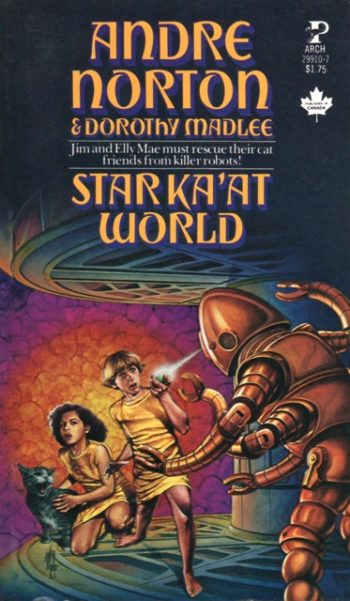The sequel to Star Ka’at, as expected, answers my main worldbuilding question: How do beings without thumbs build starships? Human children Jim and Elly find the answer in a big way, and resolve an ancient conflict in the process.
Their arrival on the Ka’ats’ world quickly makes clear how different humans and Ka’ats are, and how hard it is for humans to fit in. The Ka’ats deliver the humans and the rescued Earth cats to a refugee camp and education center, with buildings constructed by robots, and food replicated by a machine. The problem for the new arrivals—and the humans most of all—is that Ka’at machines are controlled by telepathy. The cats learn fairly quickly to run the food machine, but the humans find it impossible. Even Elly, who has a strong mental connection with the Ka’at Mer, can’t do it, and the much less adept Jim is at a loss.
The breaking point comes when both Mer and Jim’s Ka’at friend Tiro are absent, and the kids have to ask another Ka’at to operate the machine for them. The food they receive is a not very subtle message: It’s kitten food, and it isn’t particularly kind to human stomachs. If they don’t want to starve, they have to figure out a way to get their own food.
Jim’s inspiration comes from the answer to the question of the machines. The Ka’ats used to share their world with a humanoid species, the Hsi. These beings had thumbs but next to no telepathy. As with Earth humans, Ka’ats and Hsi had a few positive interactions, including one Ka’at-Hsi friendship that resulted in a starship adapted to telepathic controls. But mostly they were enemies, and the Hsi ended up destroying themselves.
Only one Hsi city remains as a warning to the Ka’ats, and all of them are taught to avoid it—it is death. Any Ka’at who ventures there never comes back.
Jim is convinced that the city won’t be death for humans, and it may offer him and Elly options for living independently. For one thing, if there is a food machine, it must have hand controls. And maybe there will be surviving Hsi, who might be more kindly disposed toward humans than toward Ka’ats.
He convinces Elly to mindtalk one of the friendly Earth cats into producing a stash of food from the food machine, and then more or less drags her into one of the smaller Ka’at flying machines, which actually have unused but functional hand controls. The Hsi who repurposed the first one didn’t trouble to remove them, and the robots who built the rest followed the original design exactly.
Jim manages to fly the machine by a bit of happy handwavium—he makes educated guesses based on a few things he remembers from Earth and helicopters—and lands it outside the Hsi city. He and Elly make it inside, discover its secrets, and have to rescue Tiro and Mer, who followed them. The two Ka’ats intended a rescue, even knowing the city will kill them. Which it nearly does, but Jim’s quick thinking saves the day—and makes the city safe for Ka’ats, who can now study its secrets. In the process, Jim finally earns Tiro’s full respect, and is named Ka’atkin, which is a huge honor.
Buy the Book


To Sleep in a Sea of Stars
Somehow the food question never really gets resolved, but maybe in the next book? Meanwhile the back and forth between humans and Ka’ats settles to a kind of equilibrium. Humans aren’t nearly as talented in telepathy, but opposable thumbs are indispensable for making and building things. The two species make a good team, once they learn to respect each other’s strengths and counter each other’s weaknesses.
Again I very vaguely remember a couple of elements in the story: the fur suits made for the humans, and the Ka’at who is so contemptuous of their inability to order their own food. I do wonder, in a writerly-worldbuilding sense, how well Ka’ats could survive without machines to feed them, since they won’t hunt and they don’t seem to farm. But then modern humans aren’t all that self-sufficient, either, without supermarkets and restaurants.
This book’s extra-special retro delights are the Hsi computers. So Seventies. So clunky. Boxes of all sizes, all the way up to gigantic, with blinky lights. Sitting here on my laptop, with my phone nearby, both of which equal if not exceed the capacity of a Seventies supercomputer, I’m all, wow, man. Those were the days. Jim actually looks for cards and paper spools, and I’m reminded of that photo of Dr. Margaret Hamilton with the enormous stack of printouts of the Apollo codes.
The robots have no perceptible intelligence, either, but that’s a choice. Asimov had already flooded the sciencefictionsphere with positronic brains and the Three Laws of Robotics. The Hsi didn’t go in that direction. Though it would have been interesting for the Ka’ats to meet a robotic intelligence and deal with it telepathically.
That’s a good thing for a reader who is a writer, for a book to suggest new spins on the worldbuilding. Especially a book intended for children. It doesn’t just tell a story. It gives the reader scope for their own imagination.
Next time I’ll move on to Star Ka’ats and the Plant People. Which is kind of an awesome title.
Judith Tarr’s first novel, The Isle of Glass, appeared in 1985. Since then she’s written novels and shorter works of historical fiction and historical fantasy and epic fantasy and space opera and contemporary fantasy, many of which have been reborn as ebooks. She has even written a primer for writers: Writing Horses: The Fine Art of Getting It Right. She has won the Crawford Award, and been a finalist for the World Fantasy Award and the Locus Award. She lives in Arizona with an assortment of cats, a blue-eyed dog, and a herd of Lipizzan horses.










